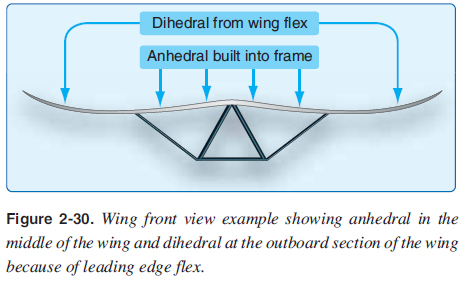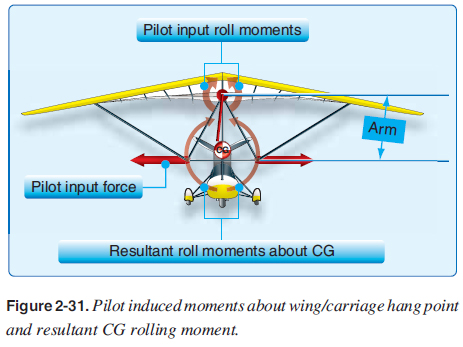
 |
|
||
CHAPTER 2. Aerodynamics Roll Stability and Moments As described in the Pilot’s Handbook of Aeronautical Knowledge, more dihedral or less anhedral in a WSC wing creates more roll stability. More roll stability might be helpful for a training wing or a fast wing made for long cross-country straight fl ight, but most pilots want a balance between roll stability and the ability to make quicker turns and a sport car feel for banking/turning. Therefore, a balance between the stability and the instability is achieved through anhedral plus other important wing design features such as nose angle, twist, and airfoil shape from root to tip. An aerodynamic characteristic of swept wings is an “effective dihedral” based on the sweep of the wing and angle of attack. The combination of the physical anhedral in the wing and the effective dihedral due to wing sweep provides the balance of stability and rolling moments for a particular wing design. The design of the wing can have actual dihedral or anhedral in the wing. Even with anhedral designed in the inboard section of the wing, the outboard sections of the wing could have some dihedral because of the fl ex in the outboard leading edges. As the wing is loaded up from additional weight or during a turn, the tips fl ex up more creating more dihedral and a roll stabilizing effect when loaded. [Figure 2-30]  Generally, it is thought that the wing remains level and the weight shifts to the side to initiate a turn. Another way to look at how the WSC wing rolls is to examine the carriage and the wing moment from the carriage point of view. For example, the CG hangs far below a wing weighing ? of the carriage weight. When the control bar is moved to the side, creating a moment about the carriage/wing hang point, the carriage stays vertical and the wing rotates around the carriage. Therefore, there are two rolling moments that both contribute to the WSC rolling into a bank:
 Carriage Moments Carriage weight and resultant CG are the main factors that contribute toward increasing the roll moment for the carriage. Carriage aerodynamic forces are not typically a factor for rolling moments. Roll Stability Summary Overall, roll stability and moments are a manufacturer/ make/model balance between dihedral/anhedral, wing twist, nose angle, airfoil shape from root to tip, and leading edge stiffness. Some designs are stable, others neutral, and others can be designed to be slightly unstable for quick side-to-side rolling. |
| ©AvStop Online Magazine Contact Us Return To Books |